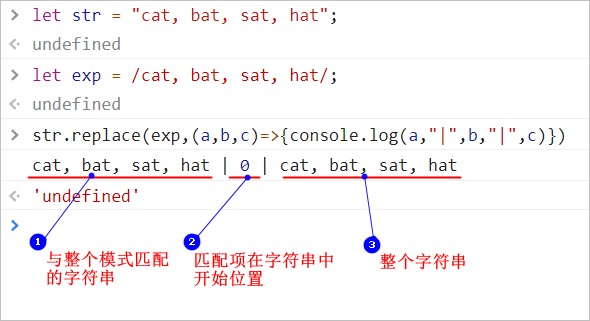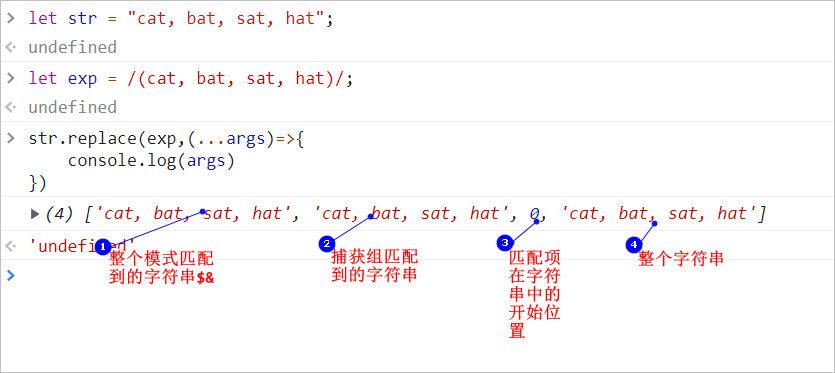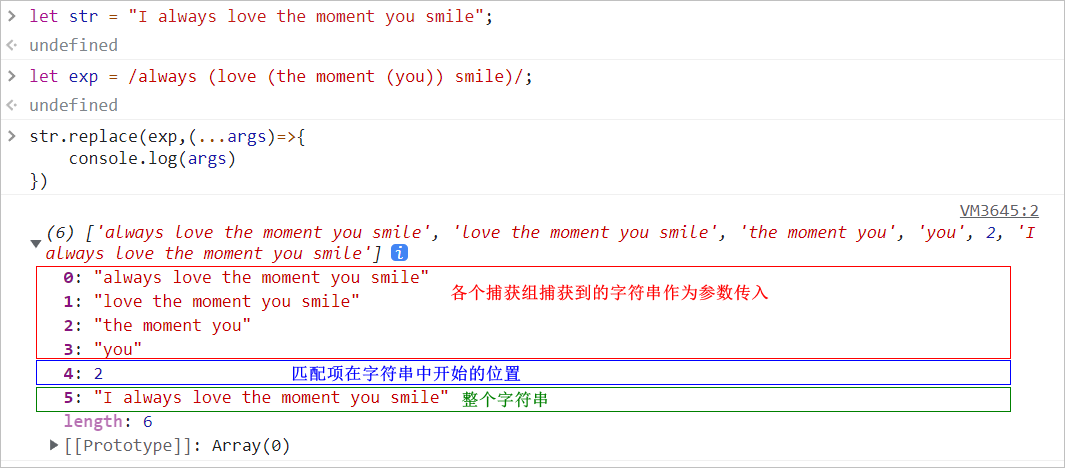1. RegExp 对象
JS 中像其他语言一样,有正则表达式的支持,即RegExp对象。
该对象主要提供了两个对象方法,分别是:
exec()test()
用法示例如下:
let str = "cat bat";
let exp = /.at/g;
exp.exec(str); // ['cat', index: 0, input: 'cat bat', groups: undefined]
exp.exec(str); // ['bat', index: 4, input: 'cat bat', groups: undefined]
exp.exec(str); // null
let str = "cat bat";
let exp = /.at/g;
exp.test(str); // true
更多参看这里 link
2. 字符串模式匹配方法
但是在处理字符串时,以上方法并不常用,取而代之,String 类型专门为在字符串中实现模式匹配设计了几个方法。
match();search();replace();
2.1 match() , search()
其中, match() 和 search() 方法的使用较为类似。 二者的使用示例如下:
let str = "cat, bat, sat, hat";
let pt = /.at/g;
let result = str.match(pt);
console.log(result);
/*
[
"cat",
"bat",
"sat",
"hat"
]
*/
let str = "cat, bat, sat, hat";
let pt = /.at/g;
let result = str.search(pt);
console.log(result); // 0
这两个方法都是接受一个参数, 是一个 正则表达式字符串,或者RegExp 对象。
所不同的是, match() 返回被匹配的项, 如果是/g 匹配模式,则返回一组包含所有匹配项的数组,否则,返回第一个匹配的到的子串, 其返回解雇结果和exec() 的执行结果相同。 而search() 的返回结果则是首个匹配项的索引值,如果没有匹配项则返回-1。
2.2 replace()
重点的需要熟悉replace() 方法, 这是最常用的方法
为了简化子字符串替换操作,ECMAScript 提供了 replace() 方法。 这个方法接收两个参数,第一个参数可以是一个RegExp对象,或者一个字符串(这个字符串不会转换为正则表达式),第二个参数可以是一个字符串或者一个函数。
也就是,repalce() 方法可以单纯的用于替换字符串中的子串,也可以用以替换匹配模式匹配的目标子串。
-
替换子字符串,示例:
let str = "cat, bat, sat, hat"; let result = str.replace("at","hello");// chello, bat, sat, hat⚠️ 注意: 如果第一个参数是字符串,那么只会替换第一个子字符串。要是想替换所有的子字符串,第一个参数必须为正则表达式并且开启了全局匹配模式。
-
替换正则匹配项,示例:
let str = "cat, bat, sat, hat"; let pt = /at/g; let result = str.replace(pt,"hello"); console.log(result);// chello, bhello, shello, hhello
2.2.1 第二个参数为字符串的应用情况
第二个参数是字符串的情况下,有几个特殊的字符序列,可以用来插入正则表达式操作的值。
| 字符序列 | 替换文本 |
|---|---|
$$ |
$ |
$& |
匹配整个模式的子字符串。等同RegExp.lastMatch |
$' |
匹配的子字符串之前的字符串。 —— RegExp.rightContext |
$` |
匹配的子字符串之后的字符串。 —— RegExp。leftContext |
$n |
匹配第 n 个捕获组的子字符串, n ( 0~9 ), 若没有捕获组,值为空串。 |
$nn |
匹配第 nn 个捕获组, nn (01~99), 若没有捕获组,值为空串。 |
以下示例说明:
let str = "I love the moment you smile";
let exp = /I (love (the moment(you)) smile/
该实例中,将会有三个捕获组:
$$
str.replace(exp,"$$"); // 将匹配到的子串替换为 `$` 符号
// '$'
⚠️ 注意: 尽管是存在捕获组,但是因为整个模式就能匹配完整的源字符串, 还是直接全部被替换为了 $ 符号。
$&
str.replace(exp,"$&"); // 'I love the moment you smile'
$' 、$`
str.replace(exp,"$'"); // ''
str.replace(exp,"$`"); // ''
// "I love the moment you smile "为首个完整匹配,其左侧,右侧都是空字符
$n、$nn
str.replace(exp,"$1"); //'love the moment you'
str.replace(exp,"$2"); //'the moment'
str.replace(exp,"$3"); //'you'
注意:
-
以上执行的含义是, 将第二个参数中的字符串,替换掉源字符串中被第一个参数(pattern)所匹配命中的子字符串。
-
以上的示例中,
$',$`的输出都是空串,以及$$直接返回$的原因是,$&作为整个pattern 命中结果,已经和源字符串相同了,即整个完整的字符串被命中。 如果做以下修改,结果将不同:let str = 'I love the moment you smile';let exp = /love (the moment (you))/;str.replace(exp,"$$")// 'I $ smile'str.replace(exp,"$'")// 'I smile smile'str.replace(exp,"$`")// 'I I smile'
所以, 一点小结: 当字符串方法replace() 的第二个参数为字符串时, replace() 方法的替换目标是 $&
以上述示例来描述,就是 字符串 "I love the moment you smile" 的原始值包装对象提供的replace() 方法, 在通过正则表达式/love (the moment (you))/ 来进行内容替换时, 将会以整个pattern(表达式)匹配到的子串为目标,即 “love the moment you” 为替换目标,也就是$& 。 并无关于pattern 中是否有捕获组。
2.2.2 第二个参数为函数的应用情况
根据是否有捕获组,表现不同
replace() 方法第二个参数还支持函数, 目的是用于更加灵活的替换规则,拓展捕获组的使用需求等。
该函数根据第一个参数中(pattern) 是否具有捕获组,函数的传递参数也不同:
- 没有捕获组时 : 函数收到3个参数 :①. 与整个模式匹配的字符串 ②. 匹配项在字符串中的开始位置 ③. 整个字符串
- 有捕获组时 : 每个匹配捕获组的字符串都会作为参数传给这个函数,但是最后两个参数,依旧是 整个匹配模式开始的位置 和 原始字符串。 因此参数的个数时不确定的,为
n + 2
以下是一些示例:
示例1 :没有捕获组:

示例2 : 只有一个捕获组:

示例3 : 有多个捕获组:

第二个参数为函数时的字符串替换示例:
示例1:
function htmlEscape(text) {
return text.replace(/[<>"&]/g, function(match, pos, originalText) {
switch(match) {
case "<":
return "<";
case ">":
return ">";
case "&":
return "&";
case "\"":
return """;
}
});
}
console.log(htmlEscape("<p class=\"greeting\">Hello world!</p>"));
// "<p class="greeting">Hello world!</p>"
❓ 这个地方存在一个疑问:
不知道当Pattern 中含有捕获组的时候要怎么去处理, 例如:
let str = "i always love the way you lie";
let exp = /always (love) the way (you) lie/;
let res = str.replace(exp, function (...args) {
for (let i = 0; i < args.length; i++) {
if (args[i] === "love") {
return "hate";
} else if (args[i] === "you") {
return "he";
}
}
});
console.log(res); //i hate
期望是将源字符串中的 "love"->"hate", "you" -> "she" 。
https://stackoverflow.com/questions/70105383/how-to-use-while-replace-methods-second-parameter-is-a-function-and-the-sam
